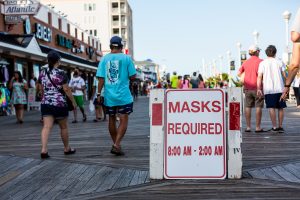
OCEAN CITY — A decision to allow certain electric bikes, or e-bikes, on the Boardwalk was put on the back burner this week by a clearly divided City Council concerned with the potential speeds they can reach.
With increased popularity of e-bikes in and around the resort area, the Bike and Pedestrian Advisory Committee (BPAC) last month reviewed the town code to determine if and where they fit into the existing ordinance covering bicycles, scooters, mopeds and other similar vehicles. The committee worked with the Ocean City Police Department (OCPD) and the owner of a bike rental shop to determine there are different classes of e-bikes, each with their own capabilities.
For example, Class 1 e-bikes are pedal-assist bikes capable of reaching speeds achieved by riders on most regular bikes. Essentially, they require riders to pedal the bikes, but their low-powered engines are ideal for riders who are rehabilitating an injury or have bad knees or other ailments.
The Class 2 and Class 3 e-bikes have higher-powered engines and throttles and are capable of reaching higher speeds. After reviewing the various classes of e-bikes and the town’s code regarding bicycles, the BPAC recommended to the Mayor and Council only allowing the Class 1 e-bikes on the Boardwalk.
Last month, the Mayor and Council debated the merits of allowing Class 1 e-bikes, or motorized bikes of any kind, on the Boardwalk in what was often a tense discussion. In a narrow 4-3 vote, the council voted to move the allowance for the Class 1 e-bikes on the Boardwalk to ordinance form. That ordinance came up for first reading during Tuesday’s meeting and the debate resumed.
Councilman Tony DeLuca, who chairs the BPAC, made a motion to approve the ordinance on first reading, a motion seconded by Councilman Mark Paddack. A vote was never taken on the motion. After considerable debate, largely over public safety on the Boardwalk and the potential speeds even the lowest class e-bike could reach, a decision was made to remand the issue back to the BPAC, which met on Wednesday, and the police commission, which meets next week, for further review.
Complicating the issue further was Councilman Matt James’ absence from Tuesday’s meeting. If the vote had been called on the motion, it was apparent it would have had a 3-3 outcome based on how the various councilmembers debated the issue. For the record, the BPAC recommended allowing only Class 1 e-bikes on the Boardwalk pending an evaluation by the police commission that it could be enforced. The committee also discussed a plan B not to allow any e-bikes on the Boardwalk because it would not be enforceable.
Council Secretary Mary Knight on Tuesday reiterated her disdain for allowing any e-bikes on the Boardwalk.
“I see e-bikes as a disaster on the Boardwalk,” she said. “I don’t want someone hit by a vehicle going 20 mph. I think this ordinance is reckless. We haven’t talked to the police department about this.”
Much of the debate on Tuesday focused on language in the proposed ordinance that states “A Class 1 electric bicycle is equipped with a motor that provides assistance only when the rider is pedaling and ceases to provide assistance when the bicycle reaches a speed of 20 miles per hour.” However, DeLuca attempted to systematically address Knight’s concerns and pointed out even riders on regular bicycles are capable of reaching 20 mph.
“The request came from the police commission to have the council review and approve this,” he said. “We did that a prior council meeting. There are three police officers from the bicycle group on the Bike and Pedestrian Advisory Committee and they all support this. A regular bike with a rider can reach speeds of 30 mph.”
Councilman Dennis Dare said his own informal research, including an interview with an e-bike owner, determined the bikes are capable of reaching even higher speeds. Dare questioned why the language regarding speed was even in the ordinance.
“I spoke with someone with one of these bikes and they told me they can go 27 mph,” he said. “Is it the right thing to do on the Boardwalk? I don’t think so. Why put a speed limit in ordinance form? That’s the part I question.”
Councilman John Gehrig said it appears his colleagues were hung up on the potential speed and not on the e-bikes themselves.
“It seems to me the issue isn’t the device, it’s the speed,” he said. “If somebody was riding a bike at 30 mph, are they going to get pulled over? Nobody should be going 20 to 30 mph on the Boardwalk on anything.”
Knight pointed out there was a precedent for setting a speed limit on the Boardwalk for a vehicle of a different sort. In 2005, the then-council voted to allow Segways on the Boardwalk, but only at a maximum speed of 6 mph. Council President Lloyd Martin also recalled the Segway decision and said he could not support the motion to allow the Class 1 e-bikes on the Boardwalk.
“I did vote against this when it came up before,” he said. “Segways are limited to 6 mph. That was approved to make the Boardwalk enjoyable for those that can’t walk it. I think we need to keep the Boardwalk for people to exercise and recreate and ride a bike, not sit on a motorized bike that’s essentially like a scooter. I just don’t think they have a place on the Boardwalk.”
Paddack pointed out it was possible for a Class 1 e-bike to reach 20 mph, but not likely practical on a crowded Boardwalk. Paddack echoed DeLuca’s sentiments the lowest class e-bike was not much different than a regular bike in terms of the speeds that can be reached. Instead, he pointed out the Class 1 e-bikes could be utilized and enjoyed by those with physical limitations that might not otherwise be able to ride a bike on the Boardwalk.
“The Class 1 e-bikes are limited to 20 mph,” he said. “When they hit that max, you have to pedal. We have a large segment of our population that are disabled or have bad knees, etc. This gives them the freedom to enjoy something you and I take for granted, like riding a bike on the Boardwalk.”
After considerable debate, DeLuca offered to amend his motion to change the language regarding speed, but it was determined the ordinance was too complicated to be amended on the fly. Instead, the issue was remanded back to the BPAC first, and later to the police commission for further review.
“I’ll gladly amend my motion if you all are concerned about the speed limit language,” he said. “The Class 1 e-bike is very similar to a regular bike. They are pedal-assist bikes that still require the rider to pedal.”
Mayor Rick Meehan pointed out there are few times an e-bike rider could reach 20 mph on the Boardwalk even if he or she wanted to.
“Right now, very seldom do you see someone going 20 mph on the Boardwalk,” he said. “It’s just not practical. When the Boardwalk is crowded, you couldn’t do that anyway.”

